When Nature Materials asked if I would write a Commentary on how I saw virtual worlds impacting our lives and science in particular, I was more than happy to share my thoughts. You can access the Commentary(1) and accompanying Editorial(2) by Joerg Heber in the December edition of Nature Materials. The following earlier draft on which the commentary is based, will I hope give Zoonomian readers unfamiliar with virtual worlds a broad introduction to some of their strengths, weaknesses and future potential.
Imagine an online phenomenon that you can engage with today, but which in ten years time will be bigger than the web, run on an infrastructure that makes Google’s hardware look like a pocket calculator, and can already deliver productivity and efficiency gains running into the hundreds of thousands of dollars. You would be there for that – right?

Well – maybe. Because despite some futuristic projections and perhaps a little wishful thinking, we are still not seeing full-on mainstream engagement with virtual worlds: the three-dimensional immersive environments where, video game style, you use a mouse and keyboard to walk and talk your personal avatar around a simulated world.
Yet recent numbers coming out of Linden Lab, owners of the dominant simulation Second Life, give pause for thought. For starters, Linden Lab say the virtual economy based on the in-world exchange of goods and services is now running at the equivalent of $500,000,000 per year. (Linden’s own income derives from virtual land sales and rentals, and virtual-real currency exchange.) Then there is the continuing enthusiasm shown for virtual worlds by big name business users like IBM, Sun and Intel – some of whom have developed their own simulations; and the host of educational and cultural institutions busily setting up their virtual shop, of which the University of Texas is the most recent and sizable example.
So what do the 70,000 or so users typically online in Second Life represent – a small entrenched community, or a portent of paradigm change in the nature of online human interaction? And what are they all doing there anyhow?
Based on my virtual wanderings, I can safely assure you that most Second Life residents are not visualizing scientific data, developing business strategies, or attending conferences and virtual universities. No – they’re mostly just having fun dressing up and forming a variety of friendships and relationships with real people projected into a fantasy setting. They’re also creating some magnificent artwork. I’m all for experiment – so good luck to them.
My own excitement about virtual worlds relates more to serious applications than fancy dress, reflecting perhaps my past life in physical and mathematical fluids modelling, or the sympathy I have as a former private pilot for flight simulation. I’m a recent convert, having discovered virtual worlds only last year while scanning for new and unusual science communication tools. Basic Second Life membership is free but, keen to establish a presence and experiment with building techniques, it wasn’t long before I’d purchased the modest plot of virtual land needed to do that. My initiation was complete when I met up with a team from Imperial College using virtual worlds for medical training – more of which later.
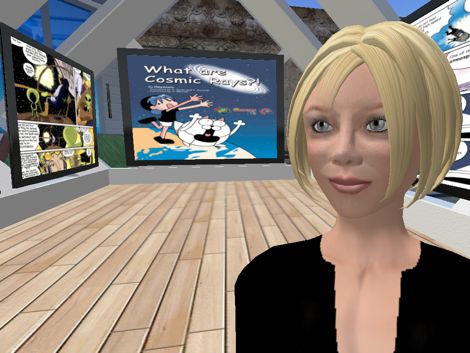
Yet mine is a minority interest. Even within my real-world community of science communicators, barely a handful of colleagues have avatars, and virtual worlds are only now starting to figure in the curriculum of science communication courses. Contacts in the UK museums sector likewise give the impression they are in no rush to engage – the argument being that the public are just not equipped or interested.
So what is the perception of users? Geeky at best. That the purpose of virtual relationships can be sexual (use your imagination) is a mixed blessing for Linden Lab: attracting some users and scaring others away. Recent measures taken to separate adult content should improve the balance.
What might it take then for virtual worlds to really take off? Can we expect another Facebook or Twitter-style growth event any time soon? Well, ask yourself why anyone might take the virtual leap? People engage where they perceive value, and that perception changes with perspective. The socialite or keen party animal, scientist, manager, and communicator will each focus on, understand, and value different aspects of virtual worlds.
First, there is a fundamental quality to virtual worlds that makes their use so attractive and could be the key driver for mainstream uptake. This special quality is a sense of space and, strange to say, something akin to a feeling of physical presence. That experience is enhanced by directional audio, such that you can hear footsteps behind you and voices get louder as avatars approach. Regrettably, this defining quality is also the most difficult to convey – you really have to experience it, which is worth remembering if you ever have to sell the concept. Significantly, those implementing the University of Texas Systems’s virtual university – covering 16 campuses no less – cite how important it was for part of their pitch to the sponsor Chancellors to be made in Second Life itself.
Talking points
I have been most impressed by the present and potential role for virtual worlds in education, and more generally as a platform for presentations and even full-blown conferencing. The many hundreds of educational establishments represented in Second Life, including major universities, attest to a pervasive interest in applying virtual worlds to learning. The arrival of large scale, well funded, projects like the Texas University System pilot, which has a research program for systematized knowledge capture built in, illustrates just how serious the ‘game’ of Second Life has become. From pilot studies like this will flow the best practices, methodologies and protocols on which the virtual universities of the not too distant future will operate.
For conferencing, substitution of the many experiences that make up a real-world event is unrealistic, but that still leaves scope for one-off lectures, classroom-less teaching scenarios, and those occasions where the trade-off of a virtual presence outweighs having no representation at all.
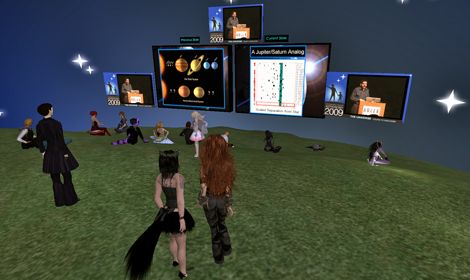
A good example is the Solo09 Science Online conference, organised in August this year, that ran simultaneously in real life at the UK’s Royal Institution in London – where I was sitting – and in Second Life for anybody who couldn’t make the venue. Virtual attendees participated fully in the discussions, and one of the speakers joined from Second Life. And importantly, the cameras were set so that we could all see each other.
The events I have joined have mostly been technically flawless, although the occasional outright disaster illustrates the danger of relaxing real world conference planning standards. Bad planning of virtual world events damages not only the organiser’s reputation but, in these early days, the credibility of the concept. Third party providers like Second Nature and Rivers Run Red with their Immersive Workspaces Solution are offering services to help clients get it right first time.
In the context of public lectures, there is a unique type of speaker-audience dynamic at work in virtual worlds that I really like, whereby protocol has somehow evolved such that audience members can comment and question, via a communal text box, during the presentation itself.
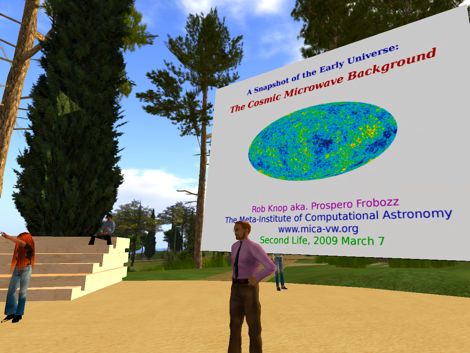
This would be pretty rude behaviour in the real world, but virtual speakers in the know seem to engage with it well, taking comments as cues to amplify audience points or elaborate on areas of the talk where there is special interest.
On the other hand, I have a real problem with the absence of any meaningful facial expression on avatars. We take expressions for granted in real life, but they deliver a lot of conscious and subconscious information that is simply lost in virtual reality. Next time you are at a real world event, make a mental note of where you are looking – it will not be the guy’s shoes. And I’m not impressed by the counter argument that expressionless anonymity makes strangers less intimidating to approach.
Good starting points for your first virtual public lecture are Second Nature at the Elucian Islands complex, NASA’s Education Island in the science rich apelago known as the SciLands, and for both public and more specialised professional astronomy talks – the Meta Institute for Computational Astrophysics (MICA). A list of science-related locations in SL can be found at this Science Center Wiki.
Private individuals and companies can hold their own virtual meetings and mini-conferences, which is a boon for geographically dispersed teams that need to work collaboratively. The benefits come through as reduced travel time, budget, and carbon footprint – with Intel claiming savings of $265,000 against one real-world meeting. Yet I suspect many traditional corporate managements are struggling to see the benefit of virtual worlds over good video-conferencing; and I do not envy anyone charged with selling virtual worlds to an unenthusiastic management.
The virtual versions of traditional collaboration aids that exist in Second Life, such as whiteboards and laser pointers, are good for highlighting features on slides and building basic flowcharts,but will disappoint those expecting the spontaneity of a flipchart. Yet workarounds that integrate ‘conventional’ two dimensional collaboration tools are possible, and we should remember that for the display of complex three dimensional objects – that can be walked around and entered – virtual worlds represent an improvement over real life. This kind of functionality is attractive to product designers, scientists, and engineers alike. A civil engineer might share a new bridge concept with a focus group, while an automotive designer might explore a vehicle prototype concept or visualise crash simulations.
In a purely commercial role, I can only envisage the most mechanical and uncontentious negotiations taking place across a virtual table; but that still leaves plenty of scope for collaborative activities including product and supply chain development. (IBM holds its most sensitive meetings behind a firewall in their own virtual world, and Linden Lab have just released a special ‘Enterprise’ version of Second Life for businesses.)
Scientific visualisations
Data visualisation and simulation are core functionalities in the virtual world where, in the scientific sphere, chemists manipulate complex molecules, climatologists visualise weather systems, and astrophysicists simulate stellar motion.
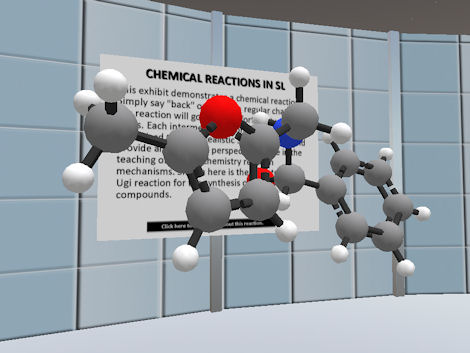
- Interactive molecule at the American Chemical Association
Modeling of fundamental physical phenomena in Second Life is constrained by the limitations of the simulation’s HAVOK physics model which, designed to support the games and movie industries, is only partly faithful to the laws of physics. Some tweaking is possible, but complex simulations require that visualisations be tied in to external processing. For example, mass in Second Life is independent of material composition but increases uniformly with object size. Different materials exhibit levels of ’slipperiness’ approximating to friction – yet viscosity and buoyancy are not represented. The delays in processing large amounts of information make accurate real time simulation problematic.

- 3 body star simulator at MICA
To explore the possibilities of data visualization for yourself, you might set up a multi-body star system simulation with the help of MICA, or get up close and personal with some carbon nanotubes at the UK National Physical Laboratories nanoscience and nanotechnology hub in the NanoLands.
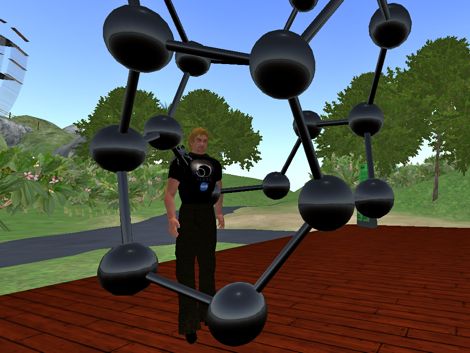
- Nanotube animation at NPL’s NanoLands
Public engagement
Virtual worlds are opening up new vistas in public engagement, ranging from the use of interactive but primarily educational displays and visualizations, through to immersive virtual consultations that impact real world policy-making.
A good example of the former is the National Oceanic and Atmospheric Administration’s presence in Second Life, where visitors can select weather systems from the Earth and other planets, and see them displayed on a giant walk-around globe – complete with audio commentary. While at NASA, the visitor can inspect and be photographed sitting atop a full size reproduction of a Saturn V launch vehicle.
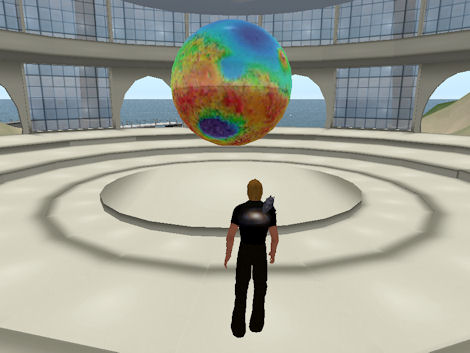
- Visualisation of Martian weather at the National Oceanic and Atmospheric Administration
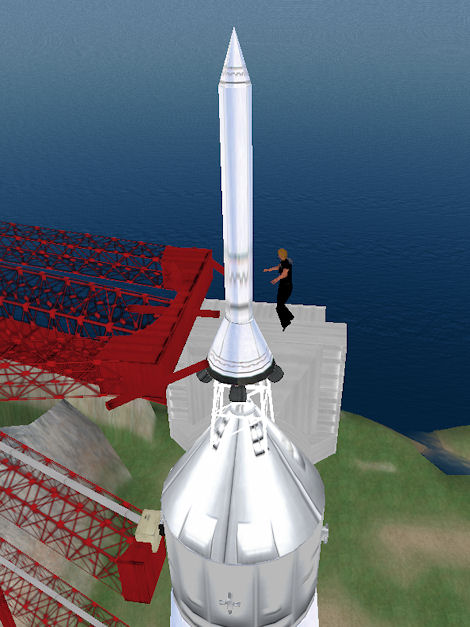
- Saturn V at NASA Education Island
A good example of virtual engagement informing real world policy is the London Strategic Health Authority’s project in association with Imperial College, involving a virtual hospital of the future that members of the public can experience and comment on.
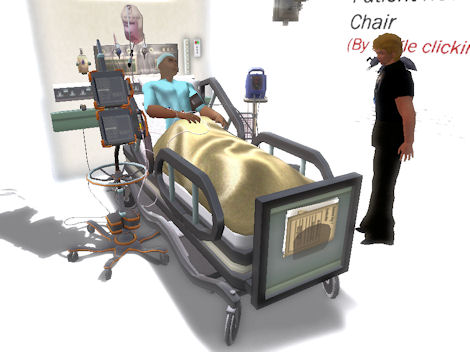
- Patient simulation at Imperial College
My most memorable virtual experience happened on this campus, when I found myself guiding and chatting with some of the 1000 or so visitors who had appeared from all over the world for an open day. Such an assembly of individuals – with the multitude of interests, professions, and languages they represented – could only happen in virtual reality. I’ve blogged about this aspect of virtual worlds before, and you can listen to the short radio documentary I made at the time here:
That event showcased techniques for the training of medical professionals, but virtual worlds are also used for direct patient treatment. It is thought stress levels in patients facing surgery can be reduced by walking them through procedures ahead of time. And for the psychologically disturbed, virtual worlds can provide a controllable, non-threatening environment in which their condition can be monitored and improved – a technique the US military has used to gain a better understanding of combat stress.
The future
While the limited processing power of users’ computers prevents an immediate Twitter-style boom in avatar births, I firmly believe we will see huge growth in both the application and awareness of virtual worlds over the next two to five years.
As hardware costs fall and broadband becomes ubiquitous, the themes of integration and interface will dominate the technical and cultural horizons of virtual worlds.
Technically, a closer integration with communications and social media applications like Facebook, Twitter, Skype, and Google has already started; for example, I can now tweet from inside Second Life. At Second Earth, a ‘mash-up’ of Google Earth data with Second Life visualization is signposting the way ahead.
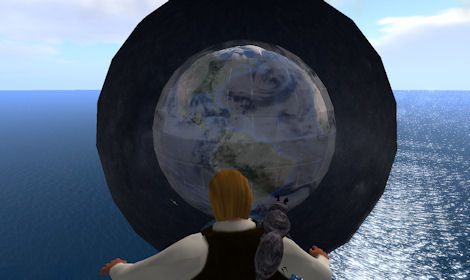
- Second Earth – A mash-up of GoogleEarth with Second Life
An inevitable move to more open standards will free avatars and virtual goods to move between different virtual worlds and other media platforms. The underlying physics models will improve, as will graphics and display technology. We will control our avatars via sensors that attach to, or remotely scan, our body and face; or we might use our brainwaves directly.
Culturally, we may find our daily routine moving seamlessly between the real and virtual worlds, in a future where avatars look and move exactly like their real world counterparts. Throwing off geek status, virtual worlds will become mainstream as more scientists, teachers, engineers, business people – and even some politicians – recognize the possibilities they offer.
All of which makes now a great time to put prejudice aside, get ahead of the game, and start checking out some of the amazing creative content and ideas that await you in the virtual universe.
Update 7/7/20011 – The Zoonomian Science Centre is no longer active, but you can still contact me in Second Life as Erasmus Magic. Or or course drop me a real-life email from the blog.
Tim Jones’s name in Second Life is Erasmus Magic
References
(1) ‘Getting real about our virtual future‘ in Nature Materials 8, 919 – 921 (2009)
doi:10.1038/nmat2580
(2) Editorial in Nature Materials 8, 917 (2009)
doi:10.1038/nmat2582
Related Links
Joanna Scott’s retrospective on the SOLO09 conference here at Nature Network
Update / Other Info
The Dutch Royal Academy of Arts and Science ‘Jonge Akademie’ invited me to talk about the themes covered in this paper and virtual worlds in general. Here are the slides from the event.
August 2010 – Linden’s attempt at a business only product just didn’t work for them. Interesting analysis here at Hypergridbusiness.com, including comments from IBM.